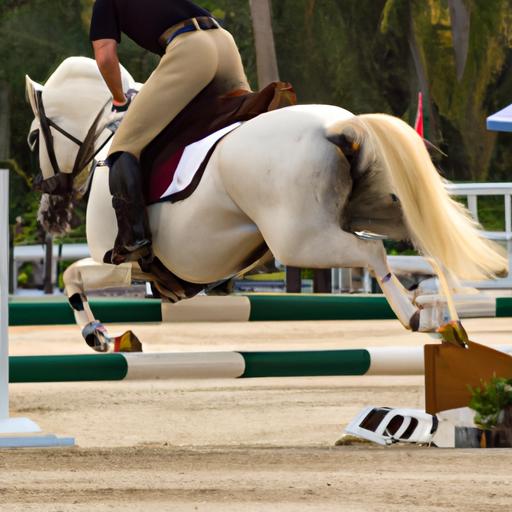Unveiling the Controversies: Explore the Opposition and Bans on horse tripping sport. Discover the organizations and jurisdictions taking a stand.
Introduction

Welcome to Horsemasterypro.com, where we delve into the fascinating world of equestrian sports. Today, we explore a controversial topic that has sparked debates among enthusiasts and animal welfare activists alike: horse tripping sport. In this article, we will delve into the definition, history, and origins of this contentious activity. So, saddle up and join me as we uncover the captivating story behind horse tripping sport.
A. Definition of Horse Tripping Sport
What exactly is horse tripping sport? Horse tripping involves roping the legs of a galloping horse, causing it to trip and fall. Participants aim to showcase their roping skills and agility while demonstrating control over the horse’s movements. This sport, often associated with certain cultural traditions, has gained attention due to its controversial nature.
B. Brief History and Origins of Horse Tripping Sport
To truly understand horse tripping sport, we must explore its historical roots. This activity can be traced back to various cultures where horse tripping was once considered a traditional practice. It played a significant role in certain cultural festivities and served as a display of horsemanship skills.
While the exact origins of horse tripping are difficult to pinpoint, historical records suggest its presence in parts of North America, Europe, and Asia. Over time, horse tripping evolved from a practical skill used for hunting and herding to a competitive sport.
As we continue our journey through the different aspects of horse tripping sport, we will delve deeper into the controversies surrounding this practice. Join me in the next section as we explore the ethical concerns and animal welfare issues associated with horse tripping sport.
Controversies Surrounding Horse Tripping Sport
Horse tripping sport has garnered significant controversy due to the ethical concerns and animal welfare issues it raises. Let’s explore these concerns and shed light on the legal status and regulations surrounding this contentious activity.
A. Ethical Concerns and Animal Welfare Issues
One of the primary concerns surrounding horse tripping sport is the potential harm inflicted upon the horses involved. Critics argue that subjecting horses to such practices puts their physical well-being at risk. The act of roping a galloping horse’s legs can lead to severe injuries, including broken bones, muscle strains, and ligament damage. These injuries not only cause immense pain and suffering to the horses but may have long-lasting consequences on their overall health.
Furthermore, opponents claim that horse tripping sport violates the principles of animal welfare. Horses, sentient beings capable of feeling pain and fear, may experience distress and trauma during these events. Advocates for animal rights argue that it is our responsibility to protect and respect the well-being of these magnificent creatures, rather than subjecting them to potentially harmful activities.
B. Legal Status and Regulations
The legal status of horse tripping sport varies across jurisdictions. In some regions, legislation has been enacted to ban or restrict this activity due to the concerns surrounding animal welfare. These laws aim to prevent the exploitation and mistreatment of horses, ensuring their protection from unnecessary harm.
However, it is essential to note that the regulations surrounding horse tripping sport can differ from one place to another. Some areas may have specific guidelines and safety measures in place to mitigate the risks associated with this practice. It is crucial for participants and organizers to be aware of and comply with these regulations to ensure the welfare of the horses involved.
As we delve deeper into the world of horse tripping sport, we will now explore the various techniques employed in this activity. Join me in the next section as we uncover the different methods used and analyze the risks and potential injuries associated with horse tripping techniques.
Horse Tripping Sport Techniques
Horse tripping sport involves a variety of techniques that participants employ to showcase their roping skills and control over the horse’s movements. Let’s explore some of the different horse tripping techniques used in this controversial sport.
A. Explanation of Different Horse Tripping Techniques
-
Leg Roping: Leg roping is the most common technique used in horse tripping sport. It involves throwing a lasso around the legs of a galloping horse, causing it to trip and fall. Participants aim for precision and timing to successfully rope the horse’s legs.
-
Neck Roping: Neck roping is another technique employed in horse tripping. Instead of targeting the legs, participants aim to lasso the horse’s neck. The rope is thrown in a way that restricts the horse’s movement, causing it to stumble and lose balance.
-
Tail Roping: Tail roping, although less common, is another technique used in horse tripping. Participants attempt to rope the horse’s tail, which can disrupt its balance and lead to a fall. This technique requires immense skill and accuracy.
B. Analysis of the Risks and Potential Injuries Involved
While horse tripping sport may be captivating to some, it is essential to acknowledge the risks and potential injuries associated with the activity. Horses, being sensitive animals, can suffer physical harm and emotional distress during these events.
The act of tripping a horse can result in severe injuries such as broken bones, sprains, and muscle strains. Additionally, horses may experience emotional trauma, impacting their trust and overall well-being. It is crucial to consider the welfare and safety of these magnificent creatures before engaging in such practices.
As we move forward in our exploration of horse tripping sport, we will delve into the cultural significance of this controversial activity. Join me in the next section as we uncover the historical importance and current popularity of horse tripping sport.
Cultural Significance of Horse Tripping Sport
Horse tripping sport, despite its controversial nature, holds historical significance in certain cultures. Let’s delve into the cultural background of this practice and explore its current popularity and participation.
A. Historical Significance in Certain Cultures
Throughout history, horse tripping sport has played a role in cultural festivities and celebrations. In some communities, it was seen as a test of horsemanship and a way to demonstrate skill and bravery. The practice often held cultural and historical significance, symbolizing the connection between humans and horses.
For instance, in certain Native American tribes, horse tripping was a traditional sport that showcased the agility and control of both horse and rider. It was considered a way to honor and respect the bond between humans and horses, highlighting the importance of horsemanship in tribal culture.
B. Current Popularity and Participation
In the present day, the popularity of horse tripping sport varies across different regions and communities. While it remains a part of cultural traditions in some areas, the practice has faced scrutiny and opposition in others.
In regions where horse tripping is still practiced, such as specific parts of the United States and Mexico, there are enthusiasts and participants who actively engage in this sport. These individuals often uphold the traditional values and cultural significance associated with horse tripping.
However, it is important to note that horse tripping sport has also faced increasing criticism and legal restrictions in many jurisdictions. Animal welfare concerns and ethical debates have led to the decline of its popularity and participation in certain areas.
As we move forward, we will explore the opposition and bans on horse tripping sport. Join me in the next section as we shed light on the organizations and individuals who stand against this controversial practice.
Conclusion
In conclusion, horse tripping sport remains a highly controversial pastime that has deep cultural roots but faces significant opposition due to ethical concerns and animal welfare issues. Throughout this article, we have explored the definition, history, techniques, cultural significance, and the opposition faced by this sport.
Horse tripping sport has been met with strong opposition from various organizations and individuals who argue for the protection and well-being of animals. These advocates believe that the practice inflicts unnecessary harm and stress on the horses involved, jeopardizing their physical and mental health.
As a result of these concerns, several jurisdictions have taken action to ban horse tripping sport. Examples include jurisdictions across the United States and other countries that have implemented legislation to prohibit the practice, recognizing the need to safeguard animal welfare.
While horse tripping sport continues to have a following among certain communities, it is evident that the opposition and bans on this activity reflect a growing societal consciousness towards animal welfare. The future of horse tripping sport remains uncertain, as the debate surrounding its ethical implications continues to evolve.
At Horsemasterypro.com, we strive to provide a comprehensive understanding of various equestrian sports, including those that may spark controversy. We encourage an open dialogue that respects differing viewpoints. Whether you support or oppose horse tripping sport, it is crucial to continue the conversation and work towards balanced solutions that prioritize the well-being of animals.
Thank you for joining me on this exploration of horse tripping sport. Stay tuned for more captivating insights into the world of equestrianism here at Horsemasterypro.com.
Horsemasterypro.com


